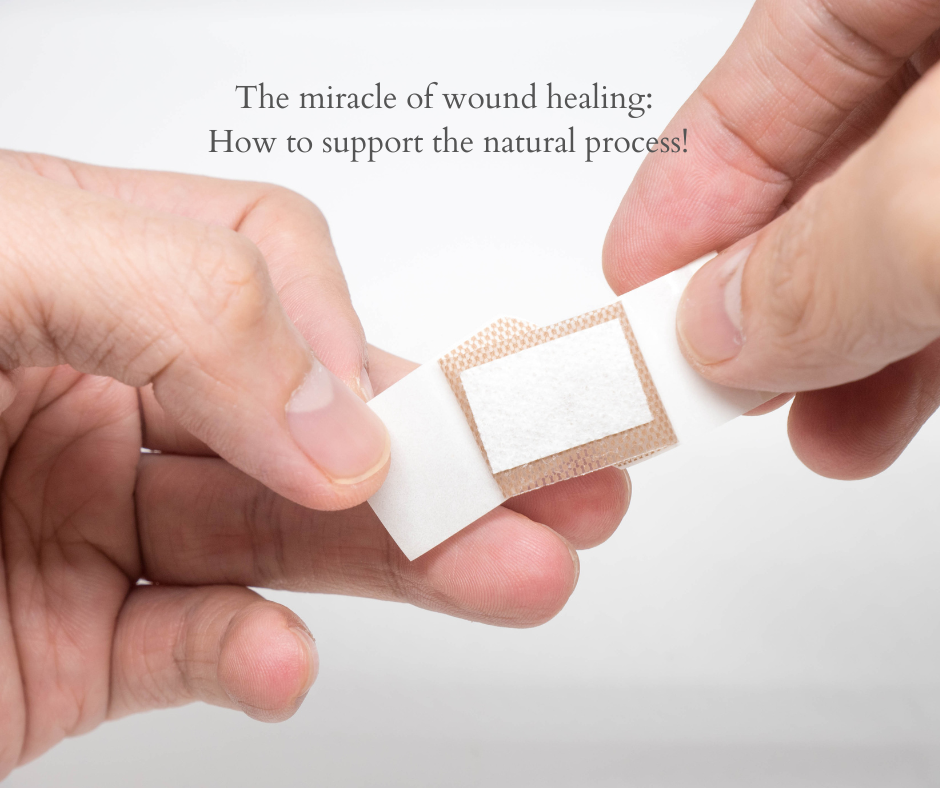Wound healing without any complications is crucial to prevent infection, dehydration or other consequential harm. There is a lot you can do to support the healing process. Learn more about the different stages, how you can support the process, risk factors and the potential of Regenerative Therapy.
When getting injured, the innate response of the body is to close the wound and repair the damagedtissue. As a natural process, it is a very complex and well-orchestrated series of events, which can be divided in 4 distinct phases:
1. Hemostasis
Usually, when skin is cut, scraped or punctured, the wound will start to bleed. Within minutes or even less, the blood cells clump together and clot to stop the bleeding. As the clots dry, they turn into a scab. They contain a protein called fibrin, which forms a net to hold them in place.
2. Inflammation
Once the wound is closed with a clot and the scab forms, the body’s immune system starts to protect the wound from infection.
3. Proliferation
During the proliferative phase of healing the wound is rebuilt with new tissue made up of extracellular matrix. As a result, the wound gets smaller.
4. Remodeling
At this stage, the wound fully closes. Collagen remodeling starts, which serves as a scaffolding. As healing continues, the new tissue gets stronger.
In healthy individuals and when cared for properly, most wounds heal well, leaving only a small scar or none at all. The larger or deeper the wound, the longer it takes to heal and the more likely is a scar.Careful wound care can speed up the stages of wound healing by keeping the affected area moist, clean and protected from reinjury and infection.
How to support wound healing
First of all, hygiene is crucial in order to prevent the penetration of germs which can result in aninfection. In addition, the wounded area should be closed with suitable wound dressings. Create moist wound environments to promote the healing process, e.g. by using hydro–active wound dressings. This supports the formation of a barrier against microorganisms and prevents from drying out and scabbing. As a result, scarring and itching are reduced. Higher positioning and immobilization of the injured part of the body can also support the process.
Another important factor is a healthy and balanced diet. Especially for large wounds, you should include plenty of fluids, protein, vitamins and trace elements in your daily diet. Berries and citrus fruits provide plenty of vitamin C and help the healing process. Make sure you get enough zinc. The mineral is essential for cell division and thus for a successful wound healing. Pumpkin seeds, oatmeal, cheese or beef are high in zinc.
Observe the wound
Is the wound healing well? You should keep an eye on it and seek medical advice immediately whenin doubt. If the area becomes thick, the skin reddens or feels warm, this all may indicate an infection. In this case, you should have it examined immediately!
When wound healing is interrupted
In fact, certain conditions and factors can slow down or even prevent the healing entirely. When the healing process is delayed, a chronic wound may develop. This is more likely to occur in patients with underlying medical disorders. There are certain medical disorders and other factors that may hinder the healing process include:
- Chronic diseases such as diabetes, metabolic disorders, anemia, and some vascular diseases restrict the blood supply to the area.
- Age: In elderly people, wounds tend to heal more slowly.
- Obesity may lead to slower wound healing due to poor blood supply to adipose tissue.
-
Poor diet may deprive the body of the nutrients it needs to heal, such as vitamin C, zinc, and proteins.
- Smoking harms healing and increases the risk of complications.
- Some medications or treatments can restrain the formation of new cells.
In the case of a “chronic wound”, no final improvement is apparent despite careful treatment. In such acase, special wound treatment must be initiated instantly, otherwise there is a risk of more serious complications.
Regenerative Therapy may support the repair of injured tissue in a natural way
Regenerative Therapies are reconstructive treatment options with the potential to accelerate the regeneration, repair or replacement of damaged tissue. They are intended to reduce pain as well as healing times and may be able to provide extensive, long-lasting coverage for wounds.
In the process of wound healing, Regenerative Therapy may support the repair and self-renewal by
- Providing building blocks for scaffolds to support reconstruction,
- Retaining moisture needed for healing,
- Creating a barrier to protect the regenerative process,
- Stimulating the repair of damaged and injured tissues.
Interested in learning more about regenerative technology for supporting natural wound healing? Please ask your Medical Provider.
*This article is meant for educational and recreational purposes only. The content of this article expresses editorial opinion only, it is not meant to provide medical advice, fact, or to provide medical recommendations on how to treat disease.
References:
https://www.betterhealth.vic.gov.au/health/conditionsandtreatments/wounds-how-to-care-for-them
https://medlineplus.gov/ency/patientinstructions/000741.htm
https://emedicine.medscape.com/article/1298129-overview
https://www.uptodate.com/contents/risk-factors-for-impaired-wound-healing-and-wound-complications

